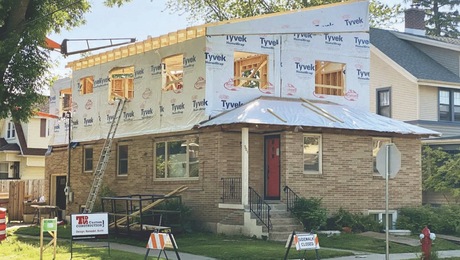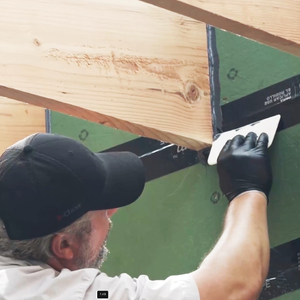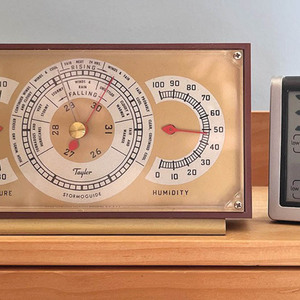Interior footings vs radiant floor slab?
I am designing a basement foundation which includes interior load bearing walls which have strip footings similar to the exterior walls. On top of these there would be a short stem wall (?) the same height as the XPS and slab.
These stem walls are normally 8″ wide so it would seem likely you could end up with that 8″ wide concrete wall sticking up out above the slab somewhat.
How do you avoid this? Narrow stem wall or monolithic slab/stem wall & sawcut all around?
Thanks
John


















Replies
What about
forming footings and stemwall sections for these interior bearing lines, up to the bottom of the slab, and then pour the slab right over the top of them? Install rebar dowels vertically in these sections, then bend them over and tie them into the rebar grid for the slab. You end up with small areas of concrete without insulation under them this way, but I'm not sure what your options are if you need direct bearing to soil within your footprint.
Interior bearing walls in residential construction are generally handled with a "thickened slab" type pour. Since the loads are not that great and the interior footins are not subject to frost conditions they seldom need to be as deep as the exterior wall footings. Depending on your soil conditions and the calculated load they generally are 12 to 16 inches wide and an addtional 6 to 10 inches of depth added to the slab in the interior footing line. Insulating under the thickened area is just a matter on cutting and installing the rigid foam. Rebar is then installed on dolby's and the radiant tubing run in the normal manner.
If this is a typical frame construction that is about all you need. If you are building the interior bearing walls with cmu's you may need to adjust your thicken slab area for width as needed to handle the addition wieght.
Sounds wrong ... or I'm not getting your description (very possible).
Basement wall w/ a load bearing wall ... I did a bunch on my own house w/ radiant slab.
As another poster said ... thickened slab at the bearing wall. Frame the wall onto the thickened slab. No stem wall needed. I didn't put anchor bolts in during the pour ... I waited and drilled and set those special anchor bolts (forget what they are called) after the fact. I did take pics of my slab/piping prior to the pour so I could know where my piping was when I went to drill and set my anchor bolts.
thickened slab and drilled/epoxied anchors sound best
Thanks Dave and Clewless, the combination of your suggestions would work nicely. I've seen a lot of thickened slab edges on commercial work but for some reason i didn't think of that for my situation.
Putting the anchors in after is probably greatly appreciated by the guy screeding (at least).
Would you just avoid those areas entirely with the radiant tubes or adjust them to make large zones for drilling after?
Thanks
John
I'd get
someone with a thermal imager to locate them before drilling.
For a few anchor locations you could do this with a low-priced IR thermometer.
Of coure, to do that you've got to have the heat on -- not likely if you're still installing walls.
Doesn't work if you need to frame now and heating the slab is in the [relatively] distant future.
I didn't realize
you guys don't have a way to heat up the tubing. it doesn't take much.
If you don't need to, why bother? Heat up the tubing; locate, rent, and/or borrow a thermal imager ... just measure and be done with it. If it was already done and he didn't know where he could drill then that might be worth the trouble. I think I left my thermal imager in my other suit.
It requires some care in planning. You can either largely avoid the area w/ e.g. only one or two crossings. But it depends on the circulation and layout of your rooms/zones. In my case, I covered two rooms w/ one zone, so there were practical limits. I criss crossed my wall w/ the tubing ... 7/8inch I think and like 16" oc.
I think the best is to lay out the tubing like you want and then measure from the walls where you want to locate e.g. 3 anchor bolts; centering them between loops. When you go to drill, you can have confidence of location. If you have tight spacing, you might want to alter it at those points ... easy to allow the tubing lines to be closer at your anchor points and then fan out again a foot away from the wall. That way, you give yourself a few more inches of confidence when you go to drill. Bottom line is to have good documentation on where your tubing is. I took pics of mine and had my tubing tied to my steel mesh reinforcing ... which allowed me to more easily determine where my tubing was.
The thermal imaging method COULD work, but usually your framing is done LONG before your system is up and running. In my case, my floor didn't see heat for at least a year after my wall framing was done.
That's the beauty of the radiant system ... you can configure much however you like and tailor it for your needs.
Anchors
Mark a couple of referance points on adjacent walls and label them. Lay out your tubing and then lay a couple of tape measures across the tubing and pulled from the referance marks. Take several pictures of the tubing with the tapes laying across it. Print the pictures, laminate them and keep them in a safe storage spot.
After your floor is poured, lay the tapes back in place to the referance marks. Use your pictures to locate the tubing at the corresponding measurements. Mark those locations on the floor with a large fet tip marker. Drill your anchor bolts in at least 3" away from any of the marks.
I do it all the time for plumbing and conduit runs beneath slabs. It just got easier and cheaper with digital cameras and computers. You can edit and annotate you photos also.
I use to make up "home owners manuals" for clients when doing remodels and additions using either Polaroid shots or prints from a 35mm SLR. If done clearly with the tapes. you can use them for years of future remodels and trouble shooting.
Interior footings & radiant
We do this a lot. I agree with Dave Richeson's method. We lay out and mark all interior walls after the rigid insulation is installed. The radiant installer then keeps his loops away from any areas that could be a problem later. It's our responsibility to advise him of anchor type and locations. I've also had to place hold downs during the footing pour to get the required imbedment depth. Tape measures and string lines are all it takes. Pouring a stem wall to top of slab height is very difficult and can almost guarantee cracks in the slab radiating from the corners. Our radiant installet staples the tubing to the rigid insulation. We use rebar for reinforcemnt and it's installed after the tubing. This keeps the tubing low in the pour and provides a little insurance for drilling or saw cutting the slab later. I think this method is superior to tying the tubing to the top of the rebar or welded wire mesh. Take measurements and lots of digital photos prior to the pour. Can't count the number of times an architect has wanted to change someting after the slab is poured and we've gone back to the photos to see if the changes could be made safley with regard to the radiant tubing. I hope this is of some help.
HV
how to keep XPS in place?
Harry/Dave, others
Thank you for the great advice.
Do you insulate under the interior footings or just the sides? Ideally I'd have 2" XPS throughout but i suspect placing it under the interior footings is not structurally recommended. Do you box the footing with XPS and leave the bottom open to bear on the existing ground? How do you keep it all in place?
John
XPS In Place
We insulate to the footings. We hold the rigid foam back to the edge of the footings so the thickened area of the slab has full bearing across the footings top. If the interior footings are quite a bit lower than the slab, we would probably pour a stem wall up closer to the bottom of the slab elavation in order to retain the backfill. I like to put our perimiter foam in place and friction fit areas I can to keep it from moving. I will also try to ramset the perimiter foam to the foundation so it does not get disloged and move up during the pour. I have never "boxed" down to a footing with rigid foam. I am afraid that a buried corner may cause a crack. You could stake the foam down with gutter spikes if you have an area you are afraid might move. The weight of the rebar helps hold the foam in place also.
Harry
Here's a shot of part of my house just before the pour. Held the insulation back to the edge of the thickened slab. Thermally it's a bit of a compromise, but I think structurally a reasonable (if not necessary) tradeoff. The footing was a bearing wall between a living area and a bedroom. You could run the tubing seperate, depending on your zoning/layout, etc as I mentioned earlier.
Hope this pic upload works ... not sure I've done it since the "upgrade".
a picture is worth a 1000 words...
Thanks Clewless
That very clearly illustrates how you left a void in the insulation for the thickened slab footing.
If you have any other similar pictures detailing that kind of pour I would really appreciate seeing them.
(You could send them to my email account rather than the forum if desired but I don't know how to do that without putting my address up and NOT getting a ton of spam.)
Thanks
John
Is the
wire mesh laying on the insulation, or was it raised before/during the pour?
It was raised during the pour. In hindsite, I'd have liked to have it on dobbies. I think I asked the contractor about this and he thought it best to not have them and he is a reputable contractor. Never had issues w/ the slab. We did a acid etched stain finish and the slabs turned our very nice and consistent. We've had no cracking issues at all and it's been in place like 5-6 yrs now.
If you are worried about the possibility of drilling through radiant tubing after the fact simply cut some 12" lengths of 1 1/2" x 1 1/2" steel angle and use electrical tape to tape them on top of the tubing ('legs down') in the area of concern. When post-pour drilling with a masonry bit if you're near a tube the drill will hit the steel, which you should be able to feel (as the steel deflects the masonry bit).
Jeff
If you are worried
Jeff, That's a great Idea!!!
Of course, don't depend on the shields not getting displaced during the pour -- belt and suspenders.
Of course, don't depend on
Belt and suspenders???????
Of course, don't depend on
Belt and suspenders???????
Yep, you got it right -- double up on the protection.